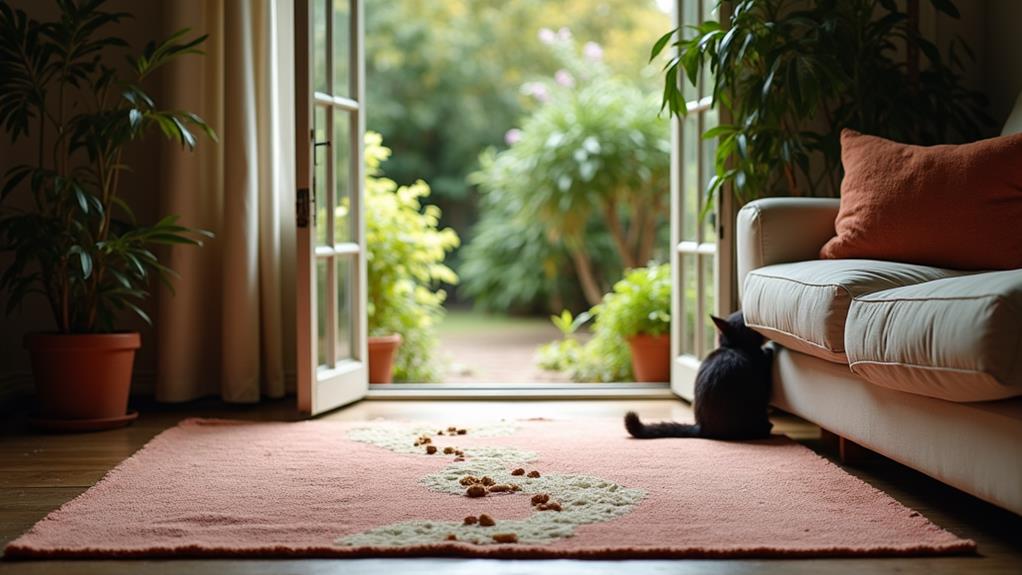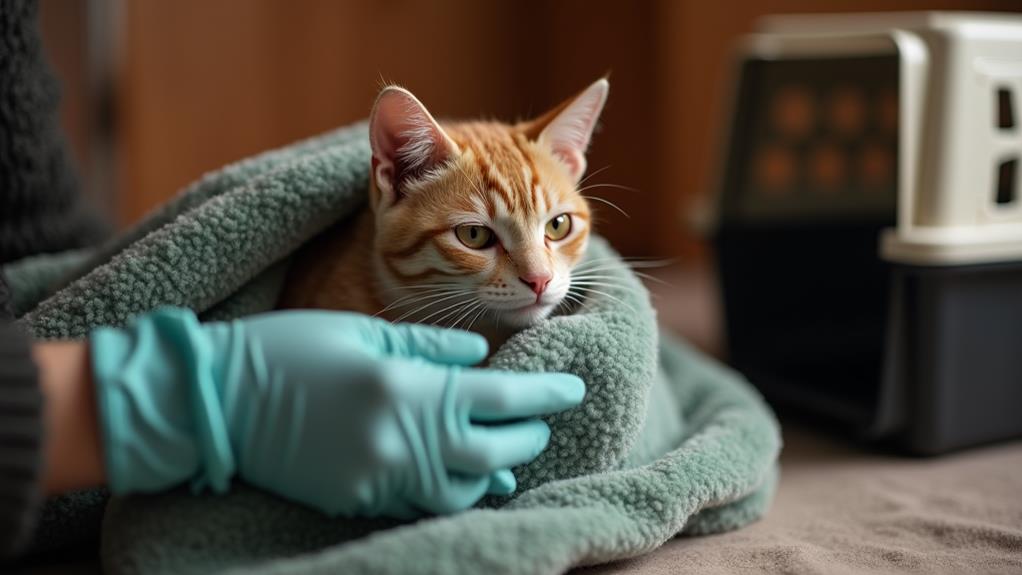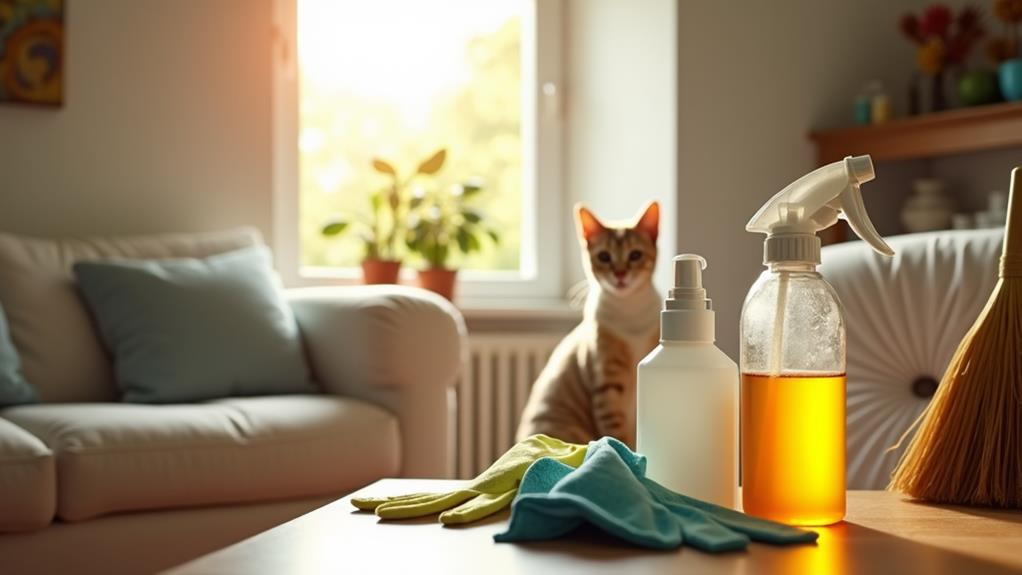How to Safely Get a Feral Cat Out of Your House

To safely remove a feral cat from your house, start by creating a calm environment. Close all doors and windows except the one you want the cat to use. Remove obstacles to clear the path. Use strong-smelling food like tuna to create a tempting trail leading outside. If necessary, set up a humane trap with bait to capture the cat. Once trapped, cover the trap with a blanket to reduce stress before transporting the cat to a safe location. Wear gloves to protect against scratches. Address health concerns with a vet. Uncover more strategies for a safe and effective process.
Recognizing Feral Cat Behavior
When dealing with a feral cat in your home, it is crucial to recognize their behavior to guarantee both your safety and the cat's well-being. Feral cats are usually wary of humans, often hiding or fleeing when approached. You might notice behaviors like hissing, growling, or swatting if they feel threatened. They're unsocialized, unlike stray cats, and will typically resist any form of contact.
Recognizing these behaviors is key to understanding their anxiety levels. Feral cats often avoid eye contact, and their rigid body language is a clear indicator of their stress and desire to escape. Pay close attention to these signs, as they can help you gauge the cat's discomfort in an unfamiliar setting.
Furthermore, feral cats tend to be more active during dusk or dawn, making them harder to spot during the day. This nocturnal nature contributes to their elusive behavior in your home. Look for supplementary signs of stress such as excessive grooming or vocalization. Understanding these behaviors will help you approach the situation with empathy and caution, ensuring that both you and the cat remain safe and unstressed during the process.
Preparing a Safe Exit Path
Creating a safe exit path is crucial for guiding a feral cat out of your home without causing extra stress. Start by verifying all doors and windows are securely closed so the cat won't escape in the wrong direction. Designate a clear exit route that leads directly outside. Remove any obstacles like furniture or clutter from this path, making it easier for the cat to navigate. This not only creates a physical path but also helps the cat feel more at ease.
Maintain a calm and quiet environment. Sudden noises or movements can startle the cat, so approach the situation with patience. Your goal is to create a safe space where the cat feels comfortable enough to move towards the exit. As you prepare, it's significant to monitor the area closely. Confirm that no other pets or people interfere with the cat's passage to the exit.
Using Food as a Lure

After setting up a safe exit path, consider using food as a lure to coax the feral cat out of your house. Start by selecting strong-smelling food sources like canned tuna, sardines, or wet cat food. These scents are irresistible to feral cats and can help draw them out from their hiding spots. Create a tempting food trail that leads from where the cat is hiding directly to a secure exit. This encourages the cat to follow the enticing aroma and safely leave your home.
Place the food in a quiet, low-traffic area to minimize stress and reduce distractions for the feral cat. This environment will make it more likely that the cat approaches the bait without feeling threatened. Use a shallow dish or container for the cat food, so the cat can access it easily and won't feel trapped or anxious.
Be sure to monitor the area closely, but maintain a respectful distance. Patience is key, as it might take some time for the feral cat to gain enough confidence to venture out for the food. By using these methods, you can safely guide the feral cat to freedom.
Humane Trapping Techniques
Sometimes, the best way to get a feral cat out of your house is through humane trapping techniques. Start by using humane traps that are specifically designed for cats. These traps should be large enough to accommodate wary feral cats and must be in perfect working condition. Building trust is essential, so before you set the trap, familiarize the cat with its presence. You can do this by placing food near the trap and gradually moving it closer inside over several days.
Once the cat is used to the trap, employ extra smelly bait like canned mackerel or tuna. Place the bait at the back of the trap to encourage the cat to enter fully. It's significant to monitor traps frequently, ideally every 30 minutes, to minimize stress on the captured cat and provide timely care.
In situations where standard traps don't work or when dealing with multiple cats, consider using drop traps. These are effective in areas where cats feel safe and can be particularly useful for capturing multiple or particularly shy feral cats. With patience and the right techniques, you can safely and humanely capture a feral cat.
Handling the Captured Cat

Handling a captured feral cat requires care and caution to guarantee both your safety and the cat's well-being. Always wear gloves when handling feral cats to protect yourself from bites or scratches. These animals can be quite fearful and aggressive when trapped. Approach the trap calmly and gently cover it with a blanket. This helps minimize stress for the cat during transport, regardless if you're heading to a veterinary check-up or a relocation site. Verify the trap is securely closed to prevent any chance of escape.
Transport the captured cat in a stable, quiet environment. This reduces anxiety and keeps the cat calm. While you have the cat in your care, monitor it for any visible health issues. Scheduling a veterinary check-up is vital, as feral cats may carry diseases that need addressing. Once the cat has been checked and treated, it's time to think about release. Choose a safe location for the cat away from human habitation. Confirm the area provides access to shelter, food, and water, aiding in its adjustment to the new environment. Proper handling and care during this process make a significant difference in the cat's well-being.
Ensuring Cat Safety
Guaranteeing the safety of a feral cat during its capture and relocation is essential. Start by wearing gloves and long sleeves to protect yourself from potential bites and scratches. Handling a feral cat can pose health risks, so it's vital to take precautions. Use humane traps specifically designed for cats to guarantee the feline's safety and comfort. These traps help in minimizing harm and guaranteeing a stress-free capture.
Once the cat is trapped, cover it with a blanket or towel. This simple step helps minimize stress and keeps the cat calm during transportation. It also reduces the chance of the cat escaping. Guarantee the environment where the cat is trapped remains quiet and free from disturbances, which can greatly help lower the animal's anxiety levels.
Monitor the health of the trapped cat closely. Look for signs of illness or distress, such as lethargy or visible injuries. If you notice anything concerning, seek veterinary care promptly. Professional attention guarantees the cat receives the proper treatment, safeguarding its well-being. By following these steps, you can effectively and safely capture and relocate a feral cat with minimal risk to both the animal and yourself.
Cleaning and Sanitizing Spaces

After successfully removing a feral cat from your home, it's vital to immediately clean and sanitize the area. Begin by donning protective gear such as gloves and masks to minimize your exposure to potential parasites and diseases carried by feral cats. Thorough cleaning is important, so prepare a mixture of water and disinfectant to tackle all affected spaces.
First, dispose of any nesting materials, droppings, and debris. Seal them in bags to prevent contamination and maintain a hygienic environment. Next, focus on disinfecting all surfaces. A solution containing bleach or another effective disinfectant will work well. Remember to ventilate the area properly during this process to guarantee your safety.
Pay special attention to areas where the cat might have left traces of odor, as these can attract more feral cats. Regularly monitor the cleaned spaces for signs of re-infestation, like new droppings or nesting signs. Sustaining cleanliness and a sanitized environment will help deter future visits from feral or stray cats.
Preventing Future Intrusions
One of the most effective ways to prevent future intrusions by feral cats is by securing your home against entry points. Regularly inspect your property for gaps in walls, windows, and doors. Seal these entry points using robust materials like steel mesh or expanding foam to keep cats away. Also, install screens on vents and chimneys to block off potential access routes, ensuring feral cats can't sneak inside your house.
Additionally, manage food sources diligently. Store pet food and garbage in animal-proof containers to eliminate attractants for feral cats. By removing these temptations, you reduce the chances of them hanging around your property. Trimming trees and shrubs near your home is another vital step. This reduces climbing access points, thereby discouraging feral cats from entering your property.
Beyond personal measures, it's important to educate neighbors about responsible pet ownership. Encourage them to spay or neuter their pets, which can greatly help reduce the local feral cat population. Collaborating with local animal control can also strengthen community efforts in preventing future intrusions. By taking these proactive steps, you not only protect your home but contribute to a humane approach to managing feral cat populations.




